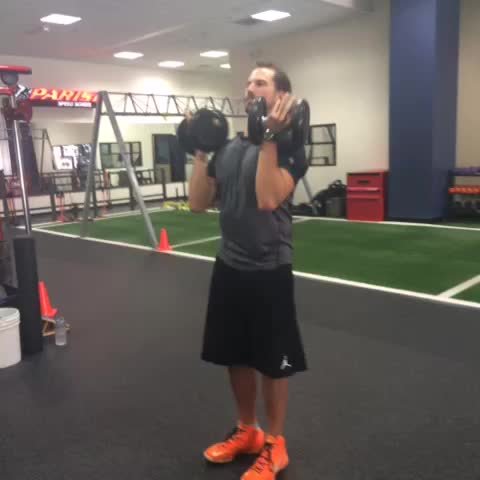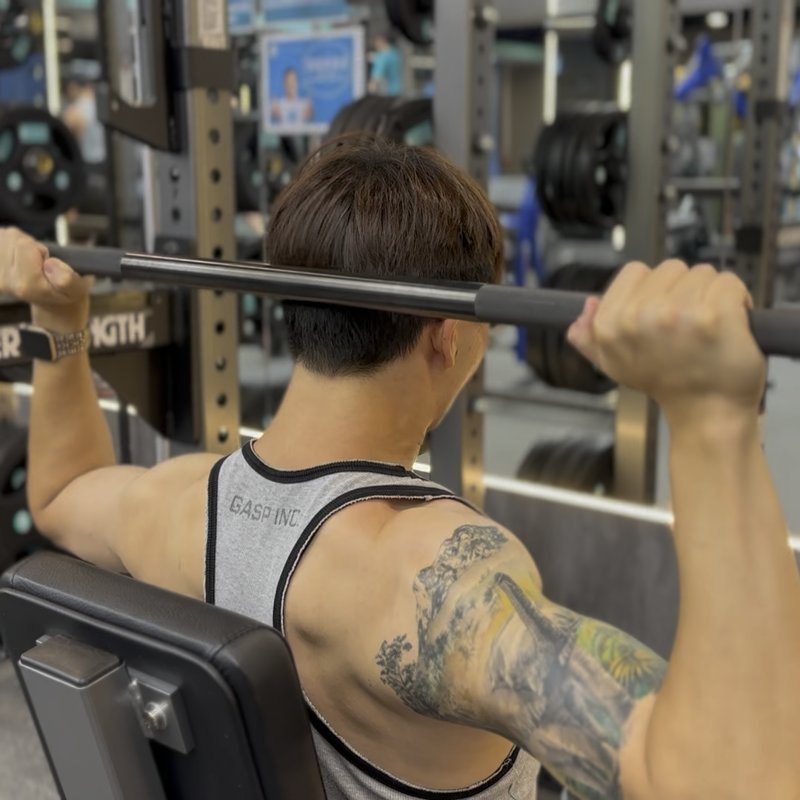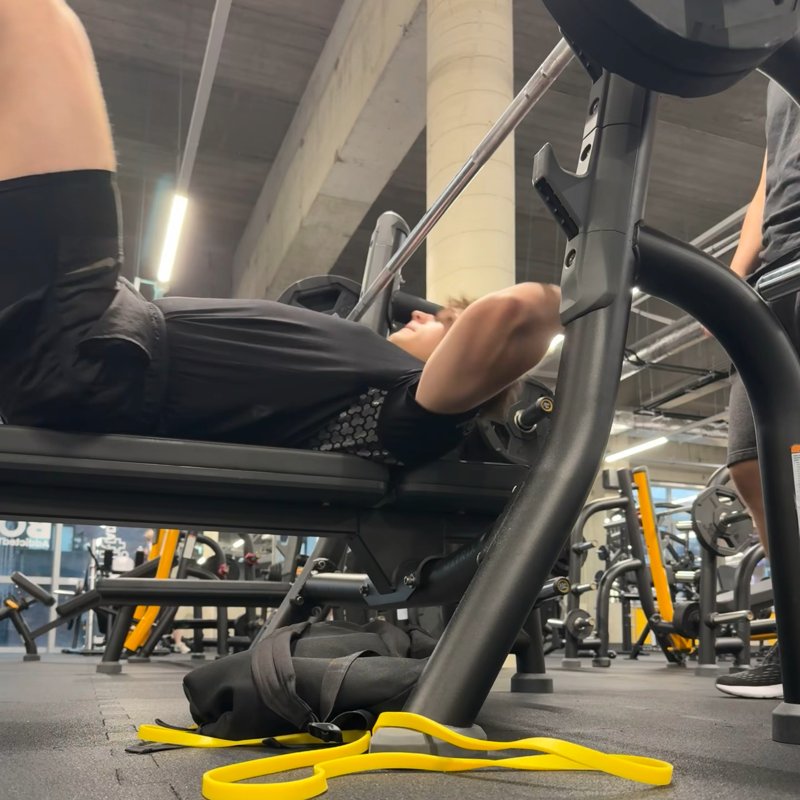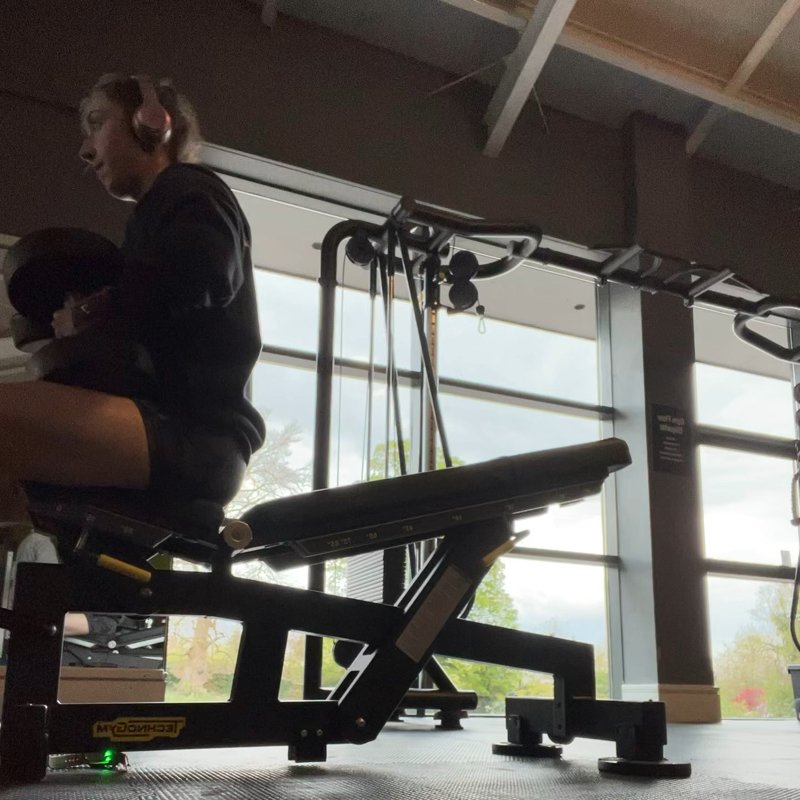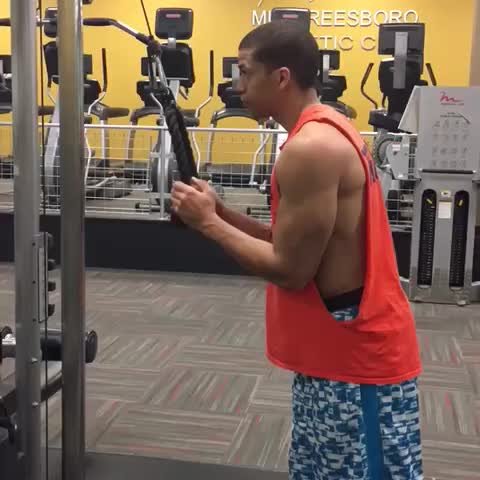Dumbbell Shoulder Press: The Ultimate Guide
The dumbbell shoulder press is a fundamental upper body exercise that primarily targets the deltoid muscles. This guide covers proper technique, variations, and programming strategies for building impressive shoulder strength and development.

Quick Facts
Key Benefit
Develops comprehensive shoulder strength and size with reduced injury risk
Primary Muscles
Anterior Deltoids, Medial Deltoids, Triceps
Secondary Muscles
Abdominals, Pectoralis Major, Pectoralis Minor, Posterior Deltoids, Traps
Equipment
Dumbbells, Incline Bench (optional)
Difficulty
Intermediate
Type
Compound, Strength, Hypertrophy
In This Guide
Ready to master the Dumbbell Shoulder Press?
Track your progress, see improvements over time, and build strength consistently.
Download GravitusThe Dumbbell Shoulder Press is one of the most effective exercises for building strong, well-developed shoulders. This powerful compound movement primarily targets the deltoid muscles while also engaging the triceps, upper chest, and core stabilizers. Unlike the barbell overhead press, the dumbbell variation allows for a more natural range of motion, can help identify and correct strength imbalances between sides, and may be more shoulder-friendly for many lifters. Whether you're looking to build massive shoulders, increase your pressing strength, or simply develop a more balanced upper body, the dumbbell shoulder press deserves a place in your training program. This guide will walk you through proper technique, common mistakes, effective variations, and programming strategies to help you get the most out of this valuable exercise.
Why the Dumbbell Shoulder Press Is Worth Mastering
The dumbbell shoulder press offers several distinct advantages that make it an essential exercise for shoulder development:
Balanced Development
Using dumbbells reveals and helps correct strength imbalances between your left and right sides, resulting in more symmetrical shoulder development.
Natural Range of Motion
Allows each arm to move through its own natural path, potentially reducing stress on the shoulder joints compared to fixed-path barbell movements.
Greater Stabilization
Requires more stabilizer muscle activation to control the independent dumbbells, resulting in better overall shoulder function and joint health.
Proper Dumbbell Shoulder Press Form: Step-by-Step
Starting Position
- Select appropriate dumbbells and either sit on an upright bench (90-degree angle) or stand with feet shoulder-width apart.
- If seated, ensure your back is supported against the bench's backrest for proper stability.
- Hold the dumbbells at shoulder height with palms facing forward or slightly inward toward each other.
- Position your elbows at approximately 90 degrees, slightly in front of your body (not directly out to the sides).
- Keep your chest up, shoulders pulled back and down, and maintain a neutral spine position.
The Movement
- Take a deep breath, brace your core, and press the dumbbells upward in a slightly arcing path.
- As you press, the dumbbells should move slightly inward (they may nearly touch at the top position).
- Continue pressing until your arms are fully extended overhead, but avoid locking out your elbows completely.
- Briefly pause at the top, maintaining full body tension.
- Slowly lower the dumbbells back to the starting position at shoulder level, following the same arcing path.
- Repeat for the desired number of repetitions while maintaining control throughout the movement.
Key Form Tips
Core Engagement
Keep your core braced throughout the entire movement to protect your lower back, especially when performing the standing variation.
Elbow Position
Your elbows should track forward and up, not directly out to the sides, to reduce shoulder impingement risk.
Shoulder Blades
Keep shoulder blades pulled back and down (retracted and depressed) throughout the movement.
Head Position
Maintain a neutral neck position; don't jut your head forward as the weights move upward.
Control the Descent
Lower the weights with at least as much control as you use to lift them, aiming for a 2-3 second lowering phase.
Range of Motion
Only press as high as your mobility allows without compromising form or experiencing shoulder discomfort.
Muscles Worked in the Dumbbell Shoulder Press
Primary Muscles
- Anterior Deltoids: The front portion of the shoulder muscles, which bear the brunt of the pressing load and are the primary movers in this exercise.
- medial deltoids: The middle part of the shoulder muscles, which assist significantly in the pressing motion, especially during the early to mid-range of the movement.
- triceps: The three-headed muscle on the back of the upper arm that extends the elbow joint during the press.
Secondary Muscles
- pectoralis major: The upper portion of the chest muscle assists during the early phase of the press, especially with a more forward press angle.
- pectoralis minor: Located along the lateral rib cage, this muscle helps to stabilize the shoulder blade during the overhead pressing motion.
- Posterior Deltoids: The rear shoulder muscles act as stabilizers during the press, helping to balance the shoulder joint.
- traps: Assists in stabilizing the shoulder girdle, particularly during the standing variation of the exercise.
- abdominals: The abdominals, obliques, and lower back muscles work isometrically to stabilize the torso, especially during the standing version.
Common Mistakes and How to Avoid Them
Excessive arching of the lower back
Arching creates the illusion of greater overhead reach but places stress on the lumbar spine. Keep your core engaged and maintain a neutral spine position throughout the movement. If standing, consider a slight staggered stance to promote better pelvic alignment.
Flaring elbows too far out to the sides
Excessive lateral elbow flare can lead to shoulder impingement. Keep your elbows positioned slightly in front of your body (not directly out to the sides) and track them forward and up during the press to protect your shoulder joints.
Stopping short on range of motion
Not going through a full range of motion reduces muscle development and mobility benefits. Lower the weights until your elbows form approximately a 90-degree angle at the bottom, and press to full extension at the top (without completely locking out).
Using momentum by leaning back
Leaning back to gain momentum turns the exercise into more of an incline press and reduces shoulder engagement. Keep your torso upright and stable throughout the movement, using only controlled shoulder strength to press the weight.
Dumbbell Shoulder Press Variations
Position Variations
-
Seated Dumbbell Press
Performed while seated on a bench with back support, this variation removes lower body involvement and allows greater focus on pure shoulder strength.
-
Standing Dumbbell Press
Performed while standing, this variation increases core engagement and overall stability requirements, making it more functional but slightly more challenging.
-
Single Arm Dumbbell Press
Pressing one dumbbell at a time increases core anti-rotation demands and helps address strength imbalances between sides.
Grip Variations
-
Neutral Grip Shoulder Press
Performing the press with palms facing each other (hammer grip) often feels more comfortable for those with shoulder issues and places slightly more emphasis on the front delts and triceps.
-
Arnold Press
Starting with palms facing you in the bottom position and rotating to palms facing forward at the top increases the range of motion and deltoid engagement throughout the movement.
-
Z-Press
Performed seated on the floor with legs extended, this advanced variation eliminates the use of lower back extension and forces strict core stabilization.
FAQs About the Dumbbell Shoulder Press
Neither variation is inherently "better"—they simply offer different benefits. The seated dumbbell press provides more stability, allowing you to focus solely on shoulder strength and potentially lift heavier weights. The standing variation engages more core muscles, has greater functional carryover to real-world activities, and may have slightly higher caloric expenditure. For optimal development, consider incorporating both variations in your training program, perhaps focusing on the seated version for pure strength work and the standing version for functional strength and core engagement.
The appropriate weight depends on your experience level, goals, and individual biomechanics. As a general guideline, choose a weight that allows you to complete all prescribed repetitions with proper form, while the last 1-2 reps of each set are challenging. For beginners, this might be 10-25 pounds per hand. Intermediates might use 25-45 pounds, while advanced lifters might press 50+ pounds per hand. Remember that shoulder training responds well to both heavy strength work (6-8 reps) and higher-rep metabolic work (10-15 reps), so varying your weight and rep ranges is often optimal for balanced development.
To overcome a shoulder press plateau, try implementing these strategies: 1) Add micro-loading by using 1.25-2.5lb weight increments rather than jumping by 5lbs; 2) Strengthen weak links—often the triceps or core stability—with targeted assistance exercises; 3) Vary your rep schemes, incorporating both lower-rep strength work and higher-rep hypertrophy work; 4) Implement new training techniques like rest-pause sets, mechanical drop sets, or tempo manipulation; 5) Ensure adequate recovery by prioritizing sleep and proper nutrition; 6) Consider deloading for a week before beginning a new progression cycle. Sometimes, simply changing the variation (seated vs. standing, or dumbbell vs. barbell) can stimulate new progress.
Video Demonstrations
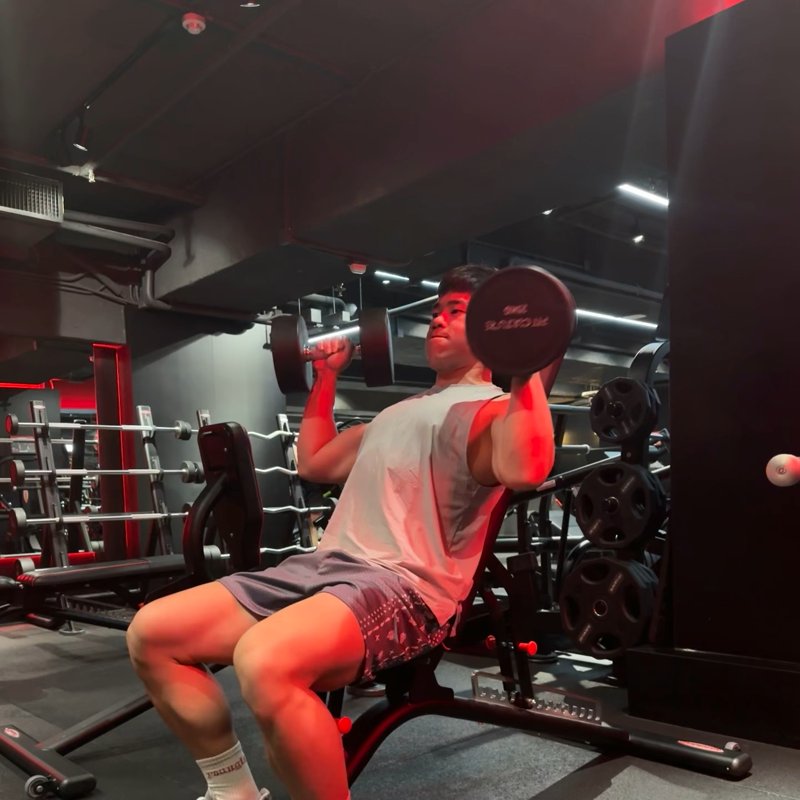
Log in to watch video demonstrations
Login to Watch3 video demonstrations available
Find more video demonstrations in the Gravitus app
Tips from the Community
-

Keep your feet planted in the ground, back flat against the bench
-

Arms at a 90 degree angle
-

Do not connect the weights together when performing the press
-

Don’t let weights shift forward, can hurt the shoulder
Track your progress with Gravitus
Download Gravitus to log your workouts, track your progress, and join a community of fitness enthusiasts.

Helpful Resources
One Rep Max Calculator
Find your one rep max for any exercise without maximal testing. Essential for developing effective strength training programs.
Calculate 1RMWorkout Programs
Follow structured workout programs created by fitness professionals to maximize your strength and muscle gains.
View Programs
